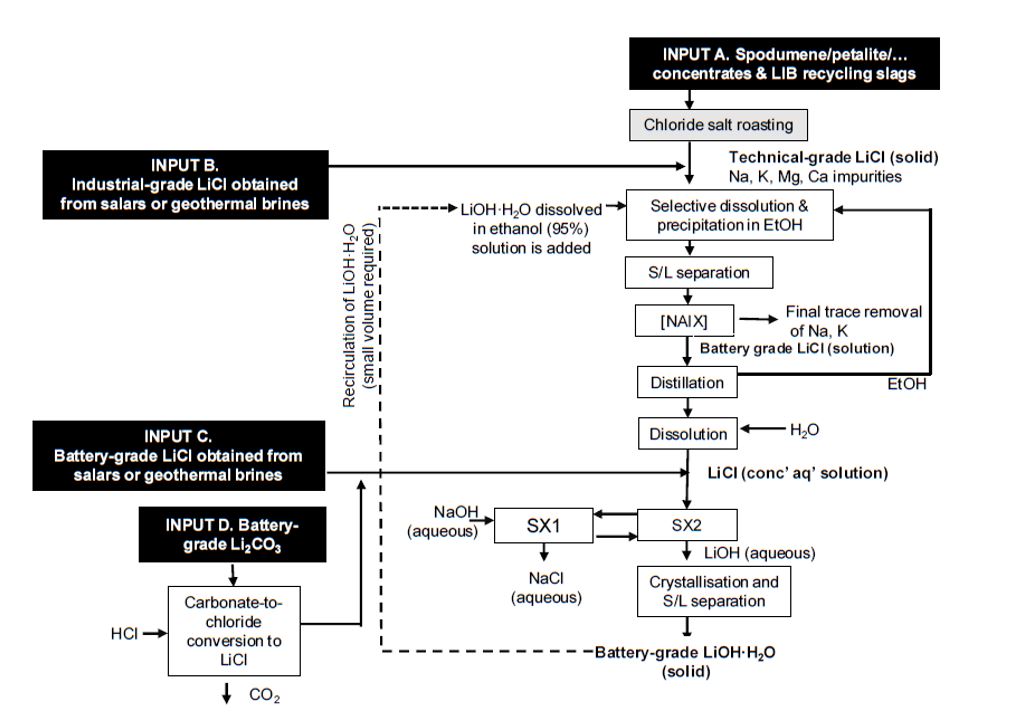In May 2020, SOLVOMET filed the patent application “Method for producing battery grade lithium hydroxide monohydrate” (priority date: 2020-05-13). The patent application (WO2021228936A1, Prof. Koen Binnemans) became public in November 2021. The first part of the patented flowsheet has now been disclosed, through a new publication in the Journal of Sustainable Metallurgy (JSM). In this open access paper, a one-step (solvometallurgical) process to purify technical-grade lithium chloride into battery-grade quality is presented. The second part of the patented flowsheet, which allows to obtain the coveted battery-grade lithium hydroxide monohydrate (LiOH·H2O) will be described in a second paper in the near future.
Why lithium hydroxide monohydrate?
The importance of lithium hydroxide, in the form of its monohydrate, is increasing rapidly, mainly because it can be used as a starting compound for nickel-rich NMC cathode materials for high-performance Li-ion batteries. A process for direct conversion of lithium chloride into lithium hydroxide, bypassing the lithium carbonate intermediate, would be advantageous to reduce the number of processing steps for obtaining lithium hydroxide. However, such process implies the purification of technical-grade lithium chloride, through the removal of common impurities such as sodium, potassium, calcium and magnesium.
Within the framework of the ERC PoC SOLVOLi and KU Leuven C3 SOLVOLi+ projects, SOLVOMET researchers have investigated a one-step process for the purification of lithium chloride to a battery-grade quality, as part of a more encompassing flowsheet to produce battery-grade LiOH·H2O (cf. patent application “Method for producing battery grade lithium hydroxide monohydrate”, WO2021228936A1 – https://patents.google.com/patent/WO2021228936A1/en) (see Figure 1)
Solvometallurgical process to purify LiCl
The details of this one-step solvometallurgical process to convert technical-grade LiCl into battery-grade LiCl have now been published in the Journal of Sustainable Metallurgy. The advantages and challenges of the process for the purification of LiCl originating either from hard-rock ores (such as spodumene) or brines are discussed. A conceptual flowsheet for obtaining battery-grade lithium chloride in a one-step solvometallurgical process is proposed in the paper.
The first part of the paper deals with the solubility studies of alkali and alkaline-earth chlorides in ethanol. It was found that it is possible to separate lithium chloride from sodium and potassium chlorides simply based on the inherent difference in solubility of these salts in ethanol.
The second part of the paper deals with the removal of magnesium and calcium ions that co-dissolved in ethanol along with lithium ions. The removal of magnesium and calcium ions was achieved by a combined dissolution/precipitation process of a chloride salt mixture in a solution of lithium hydroxide in ethanol. In this process calcium and magnesium formed hydroxides which are insoluble in ethanol, and were thus separated from lithium. High-purity lithium chloride solutions (>99.5% Li) were obtained from chloride mixtures similar to those obtained from spodumene concentrate by volatilisation of lithium chloride by roasting with calcium chloride. Lithium-rich solutions were obtained from chloride mixtures similar to lithium brine composition.
Note that, when using water instead of ethanol in the one-step dissolution/precipitation processes, sodium, potassium and calcium ions could not be efficiently separated from lithium. Hence, this process is a good example of the possibilities of solvometallurgy for the purification of battery metals, including lithium. More information on solvometallurgy can be found in the following review paper: https://link.springer.com/article/10.1007/s40831-017-0128-2.
Patent application “Method for producing battery grade lithium hydroxide monohydrate”
The results presented in the paper constitute the first part of a larger flowsheet to convert technical-grade LiCl into battery-grade LiOH·H2O (cf. patent application WO2021228936A1: Method for producing battery grade lithium hydroxide monohydrate: Priority 2020-05-13, Filed 2021-05-12, Published 2021-11-18: https://patents.google.com/patent/WO2021228936A1/en). The details of the second part of the flowsheet will be disclosed in a second paper in the near future. Companies that are interested in this patent application can contact Dr. Peter Tom Jones, Industrial Research Fund Valorisation Manager for the SOLVOMET KU Leuven Research Group, through his LinkedIn profile.
Full reference paper
Dženita Avdibegović, Viet Tu Nguyen, Koen Binnemans “One‑Step Solvometallurgical Process for Purification of Lithium Chloride to Battery Grade”, Journal of Sustainable Metallurgy, 2022, 8, 893–899. doi.org/10.1007/s40831-022-00540-w (Open Access paper).
Acknowledgements
The research leading to these results has received funding from the European Research Council (ERC) under the European Union's Horizon 2020 Research and Innovation Programme: Grant Agreement 963281 (PoC grant SOLVOLi: https://cordis.europa.eu/project/id/963281), and from KU Leuven (project C3/20/066). This publication reflects only the author's view, exempting the Community from any liability.
Figure 1. As shown in WO2021228936A1

Figure 2. Part I of the process flowsheet – as disclosed in the paper Dženita Avdibegović, Viet Tu Nguyen, Koen Binnemans “One‑Step Solvometallurgical Process for Purification of Lithium Chloride to Battery Grade”, Journal of Sustainable Metallurgy, 2022, 8, 893–899
.png)
 SOLCRIMET Advanced ERC Grant
SOLCRIMET Advanced ERC Grant
